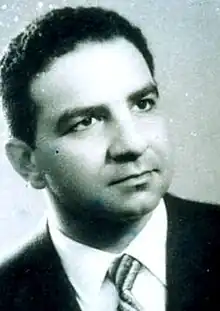Sharawi Gomaa | |
|---|---|
 | |
| Deputy Prime Minister | |
| In office 1966 – 13 May 1971 | |
| President | |
| Minister of Interior | |
| In office 1966 – May 1971 | |
| President |
|
| Preceded by | Zakaria Mohieddin |
| Personal details | |
| Born | 1920 |
| Died | 28 November 1988 (aged 67–68) |
| Political party | Arab Socialist Union |
| Alma mater | Military Academy |
Sharawi Gomaa (1920–1988) was an Egyptian military officer who served in various posts, including governor of Suez, deputy prime minister and minister of interior, during the presidency of Gamal Abdel Nasser. He was part of the May Group who were removed from the office by Anwar Sadat in May 1971.
Biography
Gomaa was born in 1920.[1][2] He graduated from the Military College.[1] He obtained a master's degree in military sciences 1951.[1] Then he worked as a teacher at the Military College.[1]
Gomaa was part of the Free Officers movement's left-wing faction.[3] He joined the General Intelligence Directorate serving as its deputy director between 1957 and 1961.[1] When the Arab Nationalist Movement (ANM) had disputes with the Syrians and the United Arab Republic was dissolved in 1961 the ANM developed direct ties with Egypt.[4] Gomaa coordinated the operations of the ANM as part of the Egyptian General Intelligence Directorate.[4]
Gomaa was appointed governor of Suez in 1961 which he held until 1964.[5] He joined the Arab Socialist Union in 1962 and was made a member of its secretariat in November 1964.[6]
Gomaa was named as the minister of interior and deputy prime minister in 1966.[5] He replaced Zakaria Mohieddin as interior minister.[5] Gomaa was named as the minister of interior in a cabinet reshuffle in May 1968.[6] During his term as interior minister he established the Police Cadets Institute in late 1960s.[7] he was the secretary general of the Arab Socialist Union in 1969[1] and was part of its secret unit, the Socialist Vanguard (Arabic: al-Tanzim al-Tali‘i), which was also called the Vanguard Organization.[8] This unit was established in 1963[8] and was headed by Gomaa and Sami Sharaf.[9] As of 1971 Gomaa was one of the Vanguard secretariat's ten members.[10]
Gomaa resigned from his post as interior minister with other Nasser supporters in the cabinet on 13 May 1971.[11][12] These officials are called the May Group.[11] Following this incident Gomaa was arrested and tried due to his alleged participation in the planned coup against Sadat.[11][13] The reason for the arrest of Gomaa and others such as Sami Sharaf was that they had been supported by the ASU, the leftist figures affiliated with the Al Tali'a magazine, and the business elites.[14] Gomaa was sentenced to death, but in December 1971 his sentence was reduced to life imprisonment.[15][16]
Gomaa was an anti-communist and supported the establishment of a capitalist state.[17] However, he was one of the Egyptian officials who preferred to get support from the Soviet Union, particularly after the defeat of Egypt in the Six-Day War in 1967.[18] He died on 28 November 1988.[1]
References
- 1 2 3 4 5 6 7 "فى مثل هذا اليوم.. وفاة شعراوى جمعة وزير الداخلية الاسبق شاهد الموضوع الأصلي من الأقباط متحدون في الرابط التالي". copts.united.com (in Arabic). 28 November 2018. Retrieved 5 November 2022.
- ↑ Amos Perlmutter (1974). Egypt: The Praetorian State. New Brunswick, NJ: Transaction Books. p. 188. ISBN 978-1-4128-2234-3.
- ↑ Raymond A. Jr. Hinnebusch (1988). Egyptian Politics Under Sadat. Boulder, CO; London: Lynne Rienner Publishers. pp. 40–41. doi:10.1515/9781685855550. ISBN 9781685855550.
- 1 2 Moshe Shemesh (2018). The Palestinian National Revival: In the Shadow of the Leadership Crisis, 1937–1967. Bloomington, IN: Indiana University Press. p. 131. doi:10.2307/j.ctv5npkcc. ISBN 9780253036599. S2CID 158990046.
- 1 2 3 Edward R. F. Sheehan (29 November 1970). "The Cairenes still cheer Nasser. Who Runs Egypt?". The New York Times. Retrieved 5 November 2022.
- 1 2 Patricia Peghini Ryan (1972). The Arab Socialist Union of Egypt (PhD thesis). West Virginia University. pp. 89, 99. ISBN 9798659245712. ProQuest 302593067.
- ↑ "An unjust trial is like living in a grave (A report on the Police Cadets Institute and holding trials in it)". ANHRI. 3 January 2021. Retrieved 5 November 2022.
- 1 2 Hesham Sallam (26 October 2020). "From the State of Vanguards to the House of Kofta: Reflections on Egypt's Authoritarian Impasse". Jadaliyya. Retrieved 5 November 2022.
- ↑ Iliya Harik (October 1973). "The Single Party as a Subordinate Movement: The Case of Egypt". World Politics. 26 (1): 98. doi:10.2307/2009918. JSTOR 2009918. S2CID 153367845.
- ↑ John Waterbury (1983). The Egypt of Nasser and Sadat. The Political Economy of Two Regimes. Vol. 515. Princeton, NJ: Princeton University Press. p. 334. doi:10.1515/9781400857357. ISBN 9780691101477.
- 1 2 3 Salwa Sharawi Gomaa (1986). Egyptian diplomacy in the seventies: a case study in leadership (PhD thesis). University of Pittsburgh. pp. 31, 33. ISBN 979-8-206-43008-0. ProQuest 303523652.
- ↑ Yasser Mohamed Elwy Mohamed Mahmoud (2009). A political economy of Egyptian foreign policy: State, ideology, and modernisation since 1970 (PhD thesis). London School of Economics and Political Science. p. 147.
- ↑ Edward R. F. Sheehan (18 July 1971). "The Real Sadat and the Demythologized Nasser". The New York Times. Cairo. Retrieved 5 November 2022.
- ↑ Pradeep Sen (1981). "Party system under Sadat. Change or continuity?". India Quarterly. 37 (3): 415. JSTOR 45071641.
- ↑ "Chronology November 16, 1971-February 15, 1972". The Middle East Journal. 26 (2): 166. Spring 1972. JSTOR 4324910.
- ↑ Raymond H. Anderson (10 December 1971). "Four Egyptians Given Life Terms". The New York Times. Retrieved 5 November 2022.
- ↑ Ibrahim G. Aoudé (Winter 1994). "From national bourgeois development to Infitah: Egypt 1952-1992". Arab Studies Quarterly. 16 (1): 11. JSTOR 41858749.
- ↑ M.S. Agwani (1980). "The Arab-Soviet Tangle". India Quarterly. 36 (2): 213. doi:10.1177/097492848003600206.